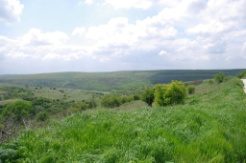

More than 20 years before, in the dry valley of Taban river, the natural border between Alafatar and Kaynardzha of Silistra, was found a unique stone complex. This includes stone altars, altars, religious fields along 4 km along the ancient Taban river banks today Malak Kanagiol, near the villages Strelkovo, Vasil Levski, Pop Rusanovo and Kutlovitsa, Silistra region.
The dry river Taban originates in the Balkans and crosses Dobruja from south to north through the steppe forest. Not far from Silistra City Kanagiol River jins it and after that they flow into the Danube through Garlitsa Lake on the Romanian territory.
The ancient rivers that dried up in the late eighteenth century, cut deep into the Sarmatic limestone carving canyons, caves and the stone. These natural phenomena drew the curiosity of the people in the region since ancient times. Thracian Getae, who ruled the region around 7-5 centuries BC, were impressed by the natural attractions along Taban river and they included it in their religeous rituals. As a center of their worship practices was chosen the most outstanding stone phenomenon in the region – over 20 meters high cliff on the eastern branch of the river Taban, at the foot of Strelkovo village, Kaynardzha municipality, Silistra region.
It is not entirely clear the purpose of their practices without precedents not only in Dobrudja but also in the provinces of Lower Danube. It is assumed that the sanctuaries on Taban river are not linked to the cult of the sun, because there is no direct light of the sun coming through and the usually sun disks are missing.
The stone temples, the altars, the underground galleries and halls on the semi-dry river are focused on the Getian – Thracian god – Zalmoxis. Describing the campaign of the Persian king Darius against the Scythians (year 514 BC), Herodotus claimed that before arriving at Istar (Danube) he conquered the Getae, who had the greatest opposition and who were the bravest and most righteous of the Thracians. Getians believed in immortality, and this is one of the reasons for their matchless courage. They thought they don’t die but they go to their God Zalmoxis also called Gebeleyzis. Every five years, they chose one of them as a messenger to Zalmoxis. Thus they were placing three children throwing the messenger from above. If he died stabbed, God was considered to be benevolent, but if he did not die, he was to blame and they would chose another ambassador.
Moreover, the same Thracians used to shoot arrows towards the sky against the god of thunder and lightning, considering that there is no other god but Zalmoxis. Moreover, Herodotus knew from the Greek colonists on the Black Sea that Zalmoxis was a slave of the famous philosopher and mathematician Pythagoras in the second half of the sixth century BC on the island of Samos. Armed with a wealth of knowledge, after being released by Pythagoras, Zalmoxis became rich and eventually returned to his compatriots, which proved with erudition and refined lifestyle. He built a hall (Andreotti), welcoming the important Getians, entertaining and teaching them that neither he nor the people around the table and their descendants will die. At the same time, he made an underground house where he lived separate from the world and in complete isolation for three years. Thracians grieved but in the fourth year Zalmoxis appeared and made them believe he was immortal.
